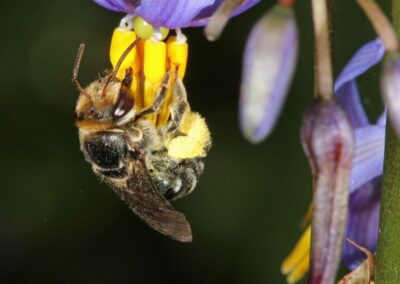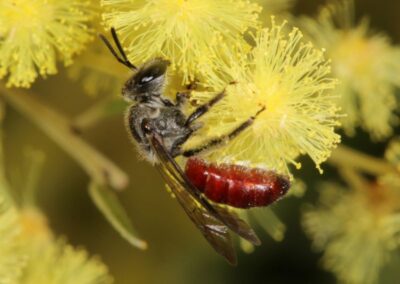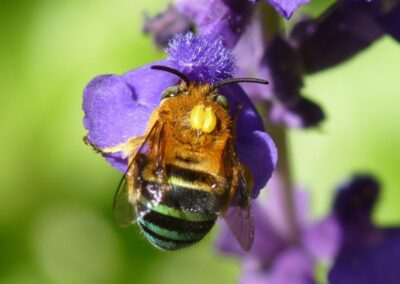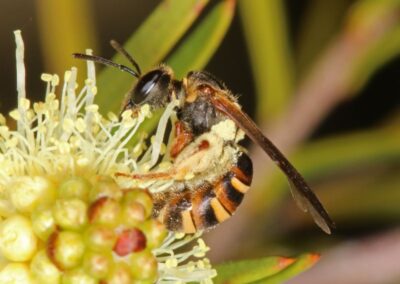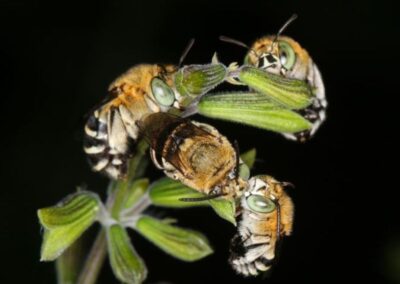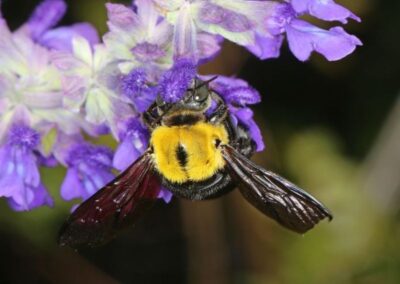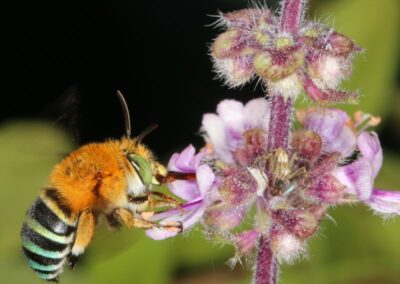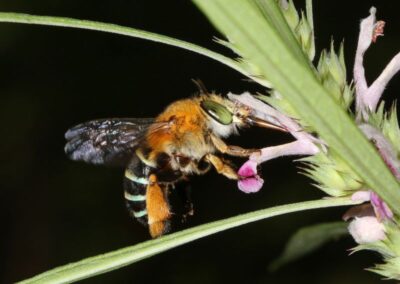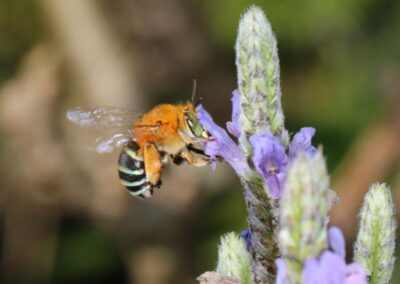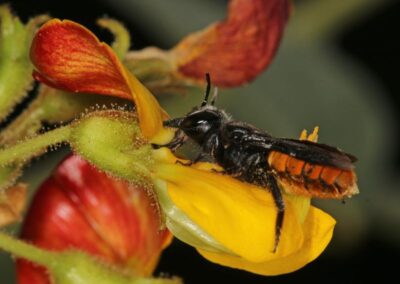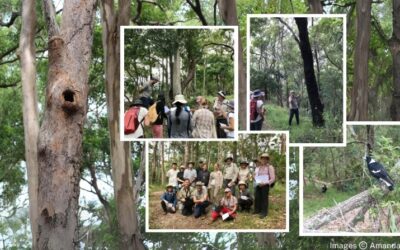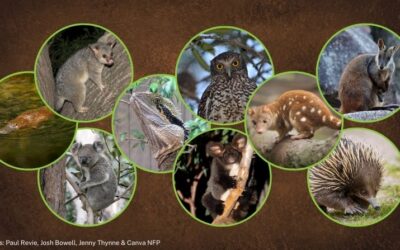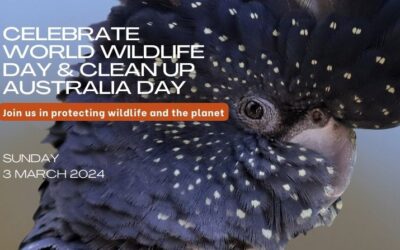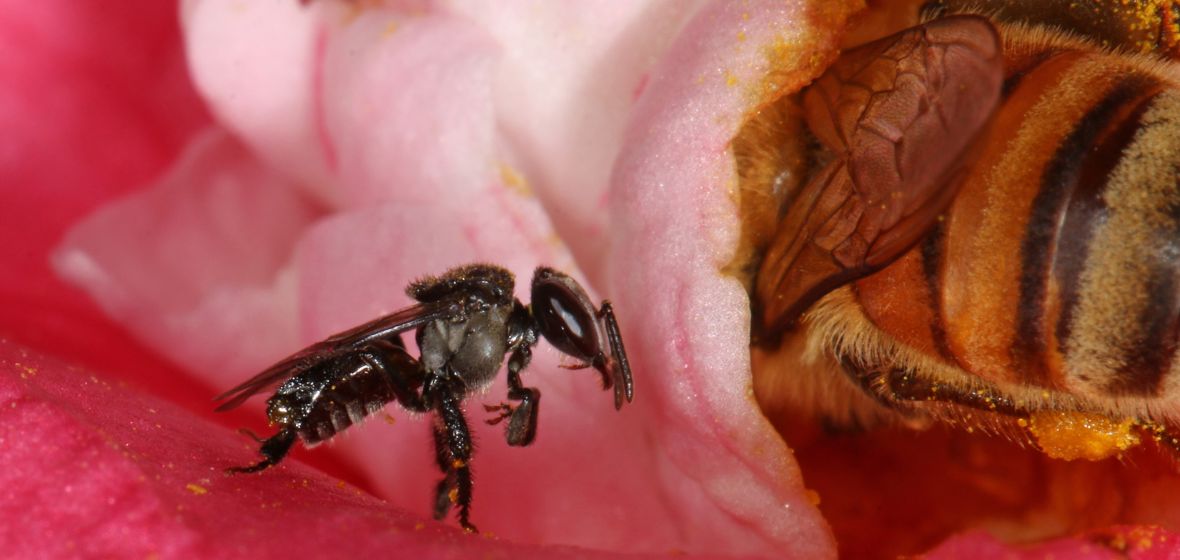
A tiny Tetragonula carbonaria stingless native bee has just landed on a partly opened camellia flower and sees the honey bee digging into the anthers and pollen. © Jenny Thynne
31 October 2023 | By Amanda Little
Establishing a bee-friendly garden or balcony is a fantastic way to aid the environment and bolster the survival of native bees and other essential pollinators. You can achieve this by selecting nectar-rich and pollen-laden plants, along with a variety of flowers that bloom throughout the year.
So which plants should you choose?
To help you make the best choices, we talked with Jenny Thynne, a dedicated volunteer at Wildlife Queensland, nature photographer and bee enthusiast. She shared her top recommendations for flowers that native pollinators adore in her bee-friendly garden in South East Queensland.
View Jenny’s top bee-attracting native and exotic plant recommendations below. You can also download the list as a PDF.
Fascinating fact!
Jenny has photographed more than 50 different native bee species that have visited her garden in South East Queensland.
Bee-attracting native plants
- Melaleucas, especially M. linariifolia
- Kunzeas
- Leptospermums
- Callistemons
- Eucalypts
- Dianellas
- Plectranthus (now Coleus)
- Syzygiums
- Hibbertias
- Westringias
- Native daisies — Brachyscome species and Xerochrysum bracteatum
- Yellow pea flowers such as Pultanaea and Dillwynia
- Purple pea flowers such as Hovea and Hardenbergia
- Tibouchinas
It’s about the little things we can each do in our gardens or on our balconies to help our local insects and wildlife.
Plant more Melalucas and Grevillias if you can. They support our birds and insects immensely. And plant flowers that will attract our native bees to assist pollination.
Bee-attracting exotic plants
- Salvias, especially deep blue ones such as ‘Indigo Spires,’ ‘Mystic Spires,’ and ‘Anthony Parker’
- Lavenders, especially French
- Grewia occidentalis
- Perennial basil
- Crepe myrtle (Lagerstroemia)
- Rondeletia
- African daisies (Osteospermum)
- Dichorisandra (also known as Purple Ginger) — loved by Amegilla (blue-banded and teddy bear bees) and Xylocopa Koptortosoma (great carpenter bees) species. You can hear them buzz pollinating on this plant.
- Plants in the Solanum family such as tomato, chilli, eggplant, capsicum
- Anise hyssop (herb)
- Motherwort (herb)
- Buddleia
- Pigeon pea (Cajanus cajun)
Where to source bee-friendly plants in Queensland
Native plants:
- The GroNATIVE app is an excellent resource to find local native plants that will attract pollinators. FREE to download from the iTunes App Store or Google Play.
- Local nurseries: Visit your local nurseries and garden centres, as many will carry a variety of native plants that can attract bees. Here in South East Queensland, we love Indigiscapes Native Nursery in the Redlands, which sells native tube stock for just $2.
- Free local native plant programs: Many local councils in Queensland run free local native plant programs, offering a range of plants to residents. Check with your local council.
- Native Plants Queensland is a community-based organisation that propagates and grows native plants for beautiful, sustainable, fauna-friendly gardens and public spaces. They hold regular Native Plants Markets which feature a huge variety of native plants from a range of growers.
Exotic plants:
- Local nurseries: Visit your local nurseries and garden centres, as they often carry a variety of exotic plants that can attract bees.
- Online plant retailers: Many online plant retailers and garden stores offer a wide selection of exotic plants. Australian Plants Online stocks a large range of bee-friendly native and exotic plants.
- Garden expos and plant sales: Look out for local garden expos, plant sales, or community events dedicated to gardening. These events often feature exotic plant vendors.
More Wildlife Blogs
5 fascinating facts about Australia’s iconic eucalypts
Eucalypts, those quintessentially Aussie trees, are a true-blue symbol of our land. With approximately 900 species of eucalypt on the planet, almost all of which are native to Australia, it’s no wonder they have their own national day on 23 March!
Who’s visiting your backyard? Identifying wildlife from their scat
Whether you’re in your backyard, exploring a park, or hiking through the bush, do you ever wonder what wildlife species are nearby? Even when wildlife isn’t readily visible, they often leave subtle traces of their presence. One such clue that nature leaves behind is scat, the faeces of animals.
Connecting people and planet on World Wildlife Day
On Sunday 3 March 2024, join us in celebrating Queensland’s incredible biodiversity and taking action to protect it. From wildlife conservation events to community clean-up efforts, there are plenty of opportunities to get involved and make a difference.

